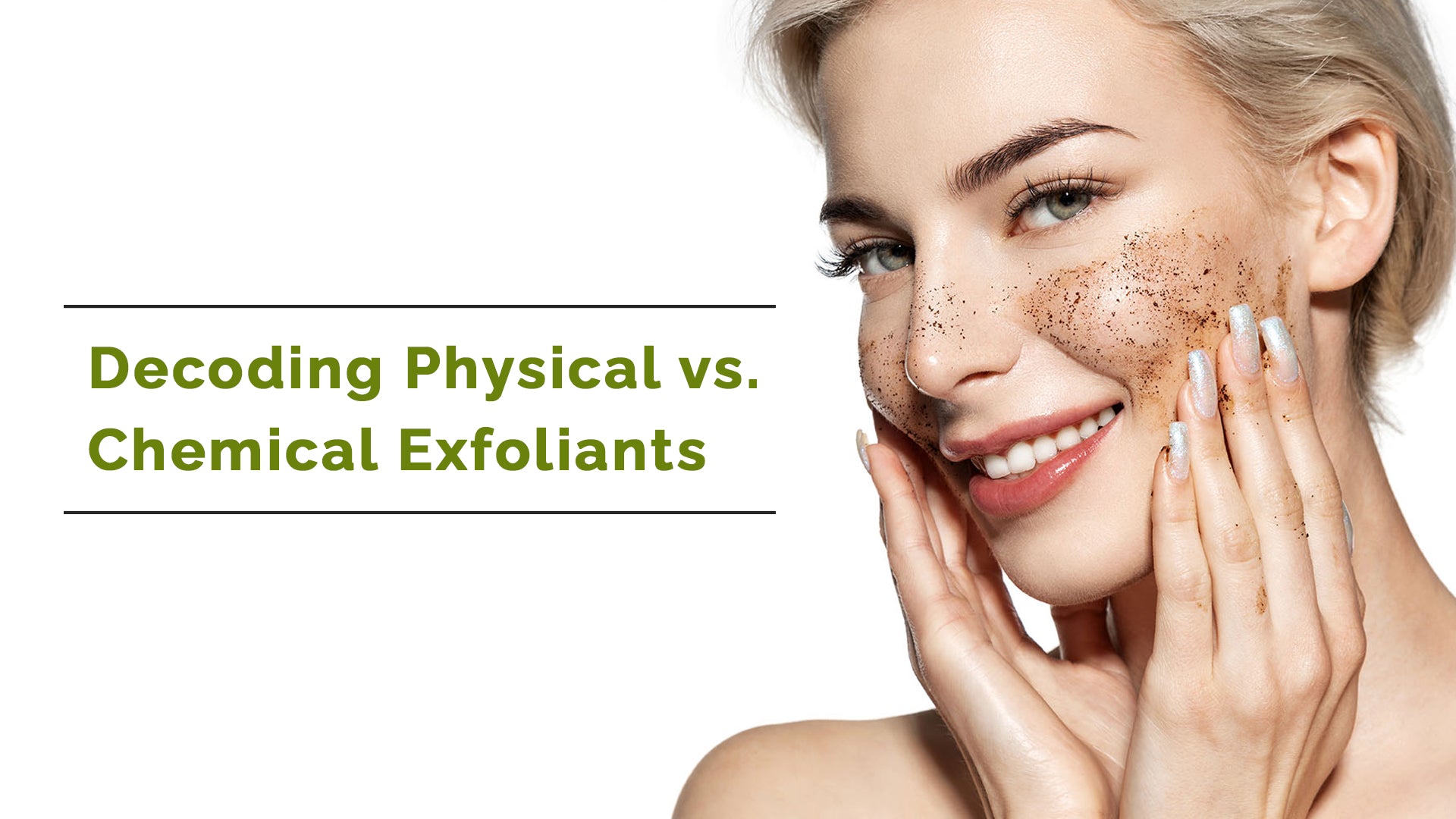Decoding Physical vs. Chemical Exfoliants

Exfoliation is a crucial step in any skincare routine, but navigating the world of exfoliants can be overwhelming. With an array of options available, it's essential to understand the key differences between physical and chemical exfoliants to choose the one that suits your skin best. In this blog, we'll decode the science behind these exfoliants and help you make an informed decision.
Physical Exfoliants: Scrubbing Away the Dead Skin
Physical exfoliants, often referred to as mechanical exfoliants, involve the use of granular substances to physically scrub away dead skin cells from the surface. These exfoliants typically contain small particles like sugar, salt, crushed fruit pits, or synthetic microbeads. When massaged onto the skin, they work by loosening and lifting the top layer of dead skin cells, revealing fresher skin underneath.
Pros of Physical Exfoliants:
- Immediate Texture Improvement: Physical exfoliants provide instant gratification by leaving the skin feeling smoother and softer right after use.
- Controlled Application: You have more control over the pressure and intensity when using a physical exfoliant, allowing you to tailor the exfoliation process to your skin's sensitivity.
- No Chemical Reactions: Since physical exfoliants do not involve chemical reactions, they are generally considered less risky for those with sensitive skin or certain skin conditions.
Cons of Physical Exfoliants:
- Potential for Over-Exfoliation: Due to the abrasive nature of some particles, excessive or harsh scrubbing can lead to over-exfoliation, causing redness, irritation, and even micro-tears in the skin.
- Uneven Exfoliation: Physical exfoliants might not evenly exfoliate the skin, potentially leaving some areas untreated while others are over-treated.
- Environmental Concerns: Many physical exfoliants contain microplastics, which are harmful to the environment and aquatic life when they wash down the drain.
Chemical Exfoliants: A Deeper Approach
Chemical exfoliants, on the other hand, use specific acids or enzymes to break down the bonds between dead skin cells, encouraging their natural shedding process. These exfoliants can penetrate deeper into the skin, offering more thorough exfoliation compared to physical methods.
There are two main types of chemical exfoliants: alpha hydroxy acids (AHAs) and beta hydroxy acids (BHAs).
- AHAs: AHAs, like glycolic acid and lactic acid, are water-soluble acids that work on the skin's surface. They are excellent for addressing fine lines, uneven skin tone, and surface-level dullness.
- BHAs: BHAs, such as salicylic acid, are oil-soluble acids that can penetrate into the pores, making them ideal for individuals with oily or acne-prone skin. They can help unclog pores and reduce the occurrence of breakouts.
Pros of Chemical Exfoliants:
- Uniform Exfoliation: Chemical exfoliants offer more even exfoliation since they can reach areas that physical exfoliants might miss.
- Deeper Penetration: Chemical exfoliants can penetrate the skin more deeply, targeting concerns beyond the surface, like clogged pores and acne.
- Less Risk of Over-Exfoliation: When used as directed, chemical exfoliants are less likely to cause physical damage to the skin compared to aggressive physical scrubbing.
Cons of Chemical Exfoliants:
- Potential Irritation: Some chemical exfoliants can cause irritation, redness, or a stinging sensation, especially for those with sensitive skin. Patch testing is recommended.
- Sun Sensitivity: AHAs and BHAs can increase sun sensitivity, making it crucial to apply sunscreen daily when using these exfoliants.
- Gradual Results: Unlike physical exfoliants that provide immediate results, chemical exfoliants may take time to show noticeable improvements in the skin's texture and appearance.
Choosing the Right Exfoliant for Your Skin
- Skin Type: Consider your skin type. Oily or acne-prone skin might benefit from BHAs, while AHAs can work well for dry or sun-damaged skin.
- Sensitivity: If you have sensitive skin, opting for a gentle chemical exfoliant with a lower concentration or a mild physical exfoliant might be a safer choice.
- Frequency: Both types of exfoliants should not be overused. Start with once a week and gradually increase frequency if your skin tolerates it.
- Ingredients: Check the ingredient list for potential allergens or irritants. Avoid exfoliants with large, jagged particles that can cause micro-tears in the skin.
- Consultation: When in doubt, consult a dermatologist. They can guide you on the best exfoliation approach based on your skin's unique needs.
Natural exfoliants that are gentle, effective and cruelty-free:
- Natural Fruit Exfoliant
- Natural Fruit Power Exfoliator
- Natural Honey Exfoliant
- Natural Polisher Exfoliant
Both physical and chemical exfoliants have their merits and considerations. The choice ultimately depends on your skin's needs, sensitivity, and your personal preferences. Whichever option you choose, remember that moderation is key, and always prioritize proper skincare practices, including sunscreen application, to maintain a healthy complexion.